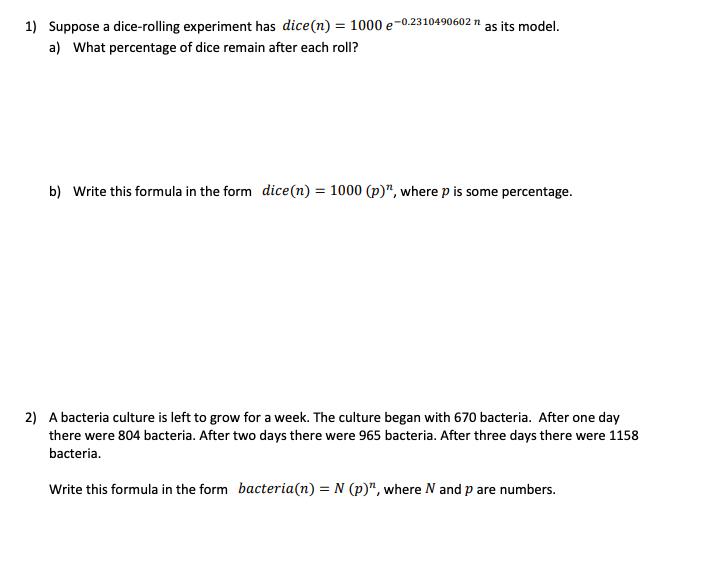Question
1) Suppose a dice-rolling experiment has dice(n) = 1000 e a) What percentage of dice remain after each roll? -0.2310490602 n as its model.

1) Suppose a dice-rolling experiment has dice(n) = 1000 e a) What percentage of dice remain after each roll? -0.2310490602 n as its model. b) Write this formula in the form dice(n) = 1000 (p)", where p is some percentage. 2) A bacteria culture is left to grow for a week. The culture began with 670 bacteria. After one day there were 804 bacteria. After two days there were 965 bacteria. After three days there were 1158 bacteria. Write this formula in the form bacteria (n) = N (p)", where N and p are numbers.
Step by Step Solution
3.44 Rating (151 Votes )
There are 3 Steps involved in it
Step: 1
1 The number of dice is given by dicen 1000e02310490602n a We see dicen1 1000e0231049...
Get Instant Access to Expert-Tailored Solutions
See step-by-step solutions with expert insights and AI powered tools for academic success
Step: 2

Step: 3

Ace Your Homework with AI
Get the answers you need in no time with our AI-driven, step-by-step assistance
Get StartedRecommended Textbook for
Applied Regression Analysis And Other Multivariable Methods
Authors: David G. Kleinbaum, Lawrence L. Kupper, Azhar Nizam, Eli S. Rosenberg
5th Edition
1285051084, 978-1285963754, 128596375X, 978-1285051086
Students also viewed these Accounting questions
Question
Answered: 1 week ago
Question
Answered: 1 week ago
Question
Answered: 1 week ago
Question
Answered: 1 week ago
Question
Answered: 1 week ago
Question
Answered: 1 week ago
Question
Answered: 1 week ago
Question
Answered: 1 week ago
Question
Answered: 1 week ago
Question
Answered: 1 week ago
Question
Answered: 1 week ago
Question
Answered: 1 week ago
Question
Answered: 1 week ago
Question
Answered: 1 week ago
Question
Answered: 1 week ago
Question
Answered: 1 week ago
Question
Answered: 1 week ago
Question
Answered: 1 week ago
Question
Answered: 1 week ago
Question
Answered: 1 week ago
View Answer in SolutionInn App



